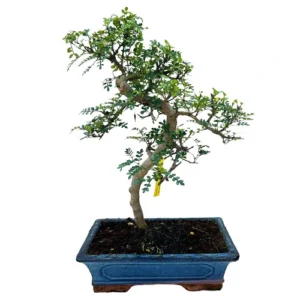Japanese Pepper Bonsai Tree (Xanthoxylum piperitum), or Chinese Pepper is an indoor species. Japanese Peppers are deciduous with small glossy green leaves
Japanese Pepper Tree (xanthoxylum piperitum)
Placement
Japanese pepper bonsai trees are mainly grown indoors in countries with a temperate climate such as the UK but in a warm climate they can be kept outside all year round. Choose a sunny windowsill or under a skylight where the tree will receive ample sunlight and warmth, taking care not to expose it to any cold draughts. Your tree should not experience drops in temperature below 10 °C, and requires temperatures of around 16-23 °C in order to thrive properly. This includes over winter time as the pepper tree requires consistent enough warm temperatures. If it is difficult to keep your pepper tree warm and with enough light over the winter, consider investing in heaters and artificial lighting.
Your japanese pepper bonsia tree tree’s growth and health would benefit from the extra sunlight and airflow that the summer months bring, so consider placing outside once it gets warm and sunny but ensure it is protected from the wind and that night temperatures do not drop under 10 °C.
Watering
There is no definitive guide to watering and it should be conducted on an observational schedule, not a routine. This means that it is important to keep an eye on the moisture levels of the soil to avoid over and under watering, both which can lead to dropping leaves and/or root death. The amount of water a bonsai requires depends on pot size, climate, airflow, soil and tree type so it is best to use your eyes and fingers to assess whether the soil is damp, wet or dry. As a general guide, if the top inch or so has dried, it is ready to be watered. When you water, ensure an even coverage over the roots and soil, allowing water to flow out from the bottom of the pot to allow for a good soaking. Never let the soil dry out completely and never let your bonsai sit in water for long periods of time.
The Japanese pepper bonsai tree also benefits from higher humidity levels. This can be achieved by using a mister to spray the leaves, as well as placing a gravel tray under the pot to create a more humid microclimate around the tree.
Fertilising
Using fertiliser on your Japanese pepper bonsai tree will help encourage healthy growth and this should be done periodically from once a week to every two months and only during the growing season. You can start adding nutrients to your water from March until October and use weekly. If using solid fertilizer, use once every one to two months. With bonsai trees, less is more and we tend to advise using half the recommended dosage to see how your bonsai reacts first.
Pruning and wiring
Pruning your bonsai is important not only to maintain or create an aesthetic style but to also ensure light and airflow can reach inner leaves and the Japanese pepper bonsai tree grows very fast in spring and summer under the right conditions. During the early to late spring months use appropriate tools to cut back stems which have grown longer than four leaves, leaving the two leaves which are closest to the stem intact. For more mature or bigger branches, the wood is hard so you will require concave scissors for thick branches.
Training your bonsai using wiring is possible but take care that the branches do not snap as they tend to be a little hard and less bendy than other species. You can wire the pepper tree throughout the year and we recommend the use of guy wires over more conventional methods.
Repotting
Repotting your tree is an important way to provide a fresh and suitable soil mix and ensure appropriate root health. As a general rule, you can repot your juniper every two to three years during early springtime. Japanese pepper bonsai tree roots grow vigorously and can and should be cut back when repotting.
Showing the single result

